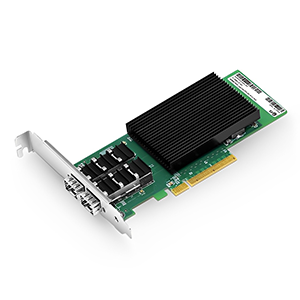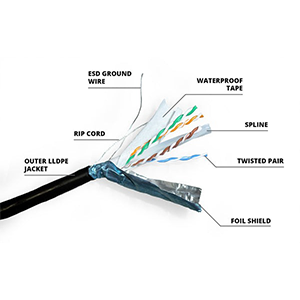As someone interested in high-speed data transmission and fiber optic technology, I am very excited to introduce you to the SFP-10G-SR optical module. This optical module is a solution for 10G Ethernet transmission supporting multi-mode optical fiber. In this article, I will introduce you to the basic principles and working methods of the SFP-10G-SR optical module, as well as its applicability and advantages in high-speed data transmission, especially in short-distance transmission and high bandwidth requirements.
Introduction to SFP-10G-SR optical module
Definition and rationale:
The SFP-10G-SR optical module is an optical module used for 10G Ethernet transmission over multi-mode optical fiber. It is a variant of Small Form-factor Pluggable (SFP) optical module that adopts the 10Gbase-SR standard. The SFP-10G-SR optical module can achieve high-speed data transmission and communication and is suitable for short-distance optical fiber connections.
The working principle of the SFP-10G-SR optical module is to utilize photoelectric conversion technology. When the electrical signal from the sending end enters the optical module, it is converted into an optical signal and transmitted through the optical fiber. At the receiving end, the optical signal is converted into an electrical signal again to achieve data transmission and reception. The SFP-10G-SR optical module supports multi-mode optical fiber, where SR stands for Short Reach and is suitable for applications with short optical fiber connection distances.
Applicability and advantages:
The SFP-10G-SR optical module has the following applicability and advantages in high-speed data transmission:
-
Short-distance transmission: SFP-10G-SR optical module is suitable for short-distance optical fiber connections, usually within a range of several hundred meters. It addresses the need for close-range communications in environments such as data centers, enterprise networks, and campus networks.
-
High bandwidth requirements: The SFP-10G-SR optical module supports a transmission rate of 10Gbps and is suitable for high bandwidth requirements. It can meet the requirements of applications such as large-capacity data transmission, high-speed data storage and video streaming.
-
Multi-mode optical fiber support: The SFP-10G-SR optical module is suitable for multi-mode optical fiber, which is relatively cheap and easy to install. It is compatible with existing multi-mode fiber optic infrastructure, providing a fast fiber optic connection solution.
-
Flexibility and replaceability: The SFP-10G-SR optical module adopts a hot-swappable design and can be plugged, unplugged and replaced during operation. This makes maintenance and upgrades of network equipment more convenient and flexible, and reduces downtime.
Application fields of SFP-10G-SR optical modules
Data center network:
SFP-10G-SR optical modules are widely used in data center networks and are mainly used to achieve high-speed data transmission and real-time data processing requirements. Here are its applications in data center networks:
-
Server interconnection: Data centers usually have a large number of servers, and these servers require high-speed and reliable interconnection. The SFP-10G-SR optical module can provide a transmission rate of 10Gbps, making data transmission between servers faster and more efficient.
-
Storage network: Storage devices in data centers require high-bandwidth and low-latency connections to support large-scale data storage and access. The SFP-10G-SR optical module can meet the high-speed connection requirements of storage networks, making data reading and writing faster and more reliable.
-
Real-time data processing: Data centers often process large amounts of real-time data, such as big data analysis, artificial intelligence, and machine learning. SFP-10G-SR optical module provides sufficient bandwidth and transmission rate
Features and specifications of SFP-10G-SR optical module
The SFP-10G-SR optical module is an optical module used for 10G Ethernet transmission. Here are its features and specifications:
-
Transmission rate and distance: The transmission rate of the SFP-10G-SR optical module is 10 Gbps (gigabit per second), which is suitable for high-speed data transmission. It is mainly used for short-distance transmission, usually covering the distance range of multi-mode fiber. Specifically, it supports transmission distances up to approximately 300 meters.
-
Fiber type: SFP-10G-SR optical module supports multi-mode fiber (MMF) type. Multimode fiber is a type of fiber that can transmit multiple light beams within the fiber. It is usually used for short-distance transmission because its transmission distance is relatively short.
-
Interface type: SFP-10G-SR optical module uses LC (Lucent Connector) interface. The LC interface is a common fiber optic connector that uses miniaturized connector size to facilitate high-density fiber optic connections. LC interfaces are widely used in many network devices, including switches, routers, and optical modules.
Technical standards and specifications for SFP-10G-SR optical modules
The main technical standards and specifications followed by the SFP-10G-SR optical module include the following:
-
10G Ethernet standard: The SFP-10G-SR optical module complies with the IEEE 802.3ae standard, which defines the physical layer and link layer specifications of 10G Ethernet. This standard covers all aspects of 10G Ethernet, including transmission rate, encoding scheme, frame format, etc. As an optical module that supports 10 Gbps transmission rate, the SFP-10G-SR optical module follows this standard to ensure its interoperability with other compatible devices.
-
Compatibility and interoperability: The SFP-10G-SR optical module has good compatibility and interoperability, which means that it can be interconnected with equipment that meets the same standards. Since SFP-10G-SR complies with the IEEE 802.3ae standard, it can seamlessly connect with other devices that follow the same standard, including switches, routers, servers, etc. This interoperability makes the SFP-10G-SR optical module a versatile choice that can be integrated with a variety of devices and network architectures.
It should be noted that although the SFP-10G-SR optical module complies with the IEEE 802.3ae standard, compatibility with specific equipment still needs to be ensured. Before using the SFP-10G-SR optical module, it is recommended to check the specifications of the relevant equipment to ensure that it supports the type and specification of the optical module.
Deployment and configuration of SFP-10G-SR optical module
The deployment and configuration of SFP-10G-SR optical modules usually require consideration of the following aspects:
-
Network topology design: In network topology design, SFP-10G-SR optical modules are usually used to connect the links between core switches and edge switches. Core switches are the backbone of the network, while edge switches connect to end devices such as servers, workstations, or other network devices. Various topologies such as star, ring, or hierarchical can be used, depending on the size and needs of the network.
Network configuration: When deploying SFP-10G-SR optical modules, some network configuration operations are required. Here are some common configuration methods:
-
Port configuration: Insert the SFP-10G-SR optical module into the SFP+ slot of the switch, and configure the corresponding port according to the specific switch model and brand. This may involve assigning a unique port number to the SFP-10G-SR optical module or enabling specific functionality.
-
Link aggregation: If you need to provide higher bandwidth and redundancy, consider using link aggregation technology. By aggregating the links of multiple SFP-10G-SR optical modules, the total bandwidth can be increased and redundancy backup provided. Link aggregation can be implemented using protocols such as IEEE 802.3ad (LACP), depending on network device support and configuration options.
-
VLAN configuration: If you need to divide the network into virtual LANs (VLANs), you can configure the corresponding VLAN settings on the switch. This enables isolation and traffic management between different VLANs to meet specific network needs.
-
QoS configuration: In order to provide priority processing for different types of traffic, Quality of Service (QoS) parameters can be configured. By configuring the SFP-10G-SR optical module with appropriate QoS policies, you can ensure that the bandwidth and latency requirements of critical applications are met.
-
These configuration methods are general guidance and specific deployment and configuration steps may vary depending on the model and brand of network equipment. It is recommended to refer to the relevant device’s user manual, configuration guide, or manufacturer’s technical support resources for detailed deployment and configuration instructions.
Optimization and troubleshooting of SFP-10G-SR optical module
Optimization and troubleshooting of SFP-10G-SR optical modules can involve the following aspects:
Performance optimization:
-
Signal conditioning: Ensure the stability and quality of fiber optic connections. Check the cleanliness of the fiber optic connection and ensure that the connector at the end of the fiber optic cable is not dirty or damaged. Use a laptop or fiber testing equipment to check fiber connectivity and signal strength and make adjustments as needed.
-
Link optimization: When deploying SFP-10G-SR optical modules, ensure the best performance of the link. Avoid excessively long fiber distances to reduce signal attenuation. Use the appropriate fiber type and gauge to meet the expected transmission distance requirements. Use link aggregation technology as needed to increase bandwidth and redundancy.
-
Network device configuration optimization: Optimize configurations on switches and other network devices to ensure optimal performance. Configure appropriate buffer sizes, QoS parameters, and traffic control policies to meet network demands and optimize bandwidth utilization.
troubleshooting:
-
Connection problem: If the SFP-10G-SR optical module cannot work properly, first check whether the optical fiber connection is correct. Make sure the fiber is inserted into the correct interface and slot, and check that the connectors are properly aligned and locked. Clean the connector and reinsert the fiber to eliminate possible contact issues.
-
Compatibility issues: If the SFP-10G-SR optical module cannot communicate with other devices, there may be compatibility issues. Confirm compatibility between devices and optical modules, including supported fiber types, rates, and protocols. Check that device firmware and drivers are up to date and update if necessary.
-
Error messages and logs: Check the error messages and logs of the switch or other network device to obtain fault information about the optical module. These logs may contain information about link status, error counts, and exceptions that can help determine the root cause of the problem.
-
Fault replacement: If the problem still cannot be solved after troubleshooting, you may need to consider replacing the SFP-10G-SR optical module. Ensure that the replacement optical module used matches the device and network requirements, and reconfigure and test as needed.
If you encounter complex faults or problems, it is recommended to consult the technical support of the network equipment manufacturer or seek help from a professional network engineer for more detailed troubleshooting guidance.
Summarize:
SFP-10G-SR optical modules play an important role in data center networks and enterprise networks. It supports a transmission rate of 10 Gbps, is suitable for short-distance transmission, and is compatible with multi-mode optical fiber and LC interfaces. Following the 10G Ethernet standard, the SFP-10G-SR optical module has good compatibility and interoperability and can be interconnected with other devices that meet the same standards.
In terms of deployment and configuration, network topology design and network configuration are key factors to ensure the effective operation of the SFP-10G-SR optical module. In addition, performance optimization and troubleshooting are also important aspects to ensure the stability and reliability of optical modules. We hope this article has provided you with valuable information about the SFP-10G-SR optical module and helped you better understand and apply this advanced optical fiber transmission technology.
- What is SFP-10G-SR?
- What is SFP optical module?
- What is 10G SFP module?
- What is the difference between SFP-10G-LR and SFP-10G-SR?
- What is the difference between SFP and optical?
- What is the difference between SFP and SFP module?
- Is SFP-10G-SR single mode or multimode?
- Does SFP-10G-SR support 1G?
- What is the minimum distance for SFP-10G-SR?
-
25G SFP28 1310nm 10km LC Optical Transceiver Module
-
25G SFP28 1310nm 30km LC Optical Transceiver Module
-
25G SFP28 850nm 100m LC Optical Transceiver Module
-
25G SFP28 850nm 300m LC Optical Transceiver Module
-
25G SFP8 1300nm 80km LC Optical Transceiver Module
-
25G SFP8 1310nm 40km LC Optical Transceiver Module



